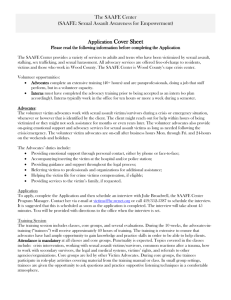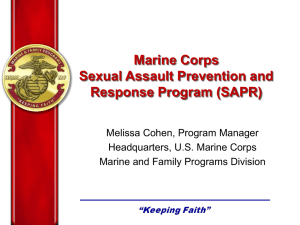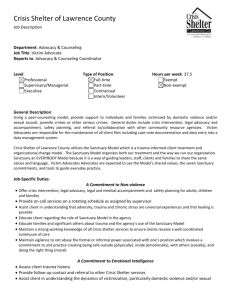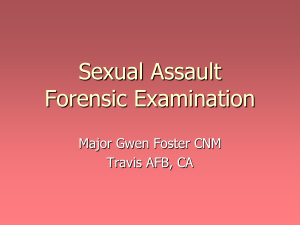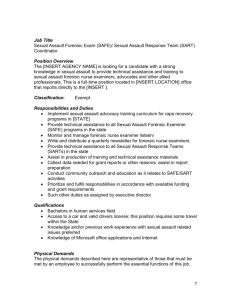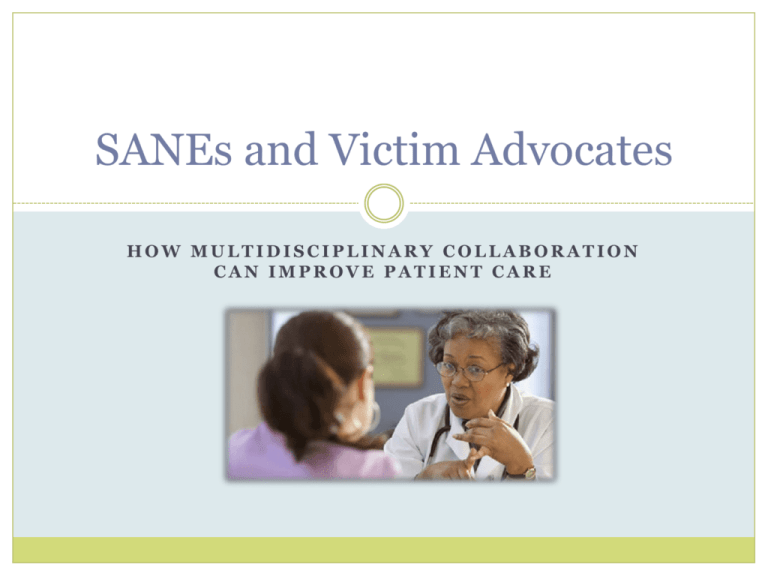
SANEs and Victim Advocates
HOW MULTIDISCIPLINARY COLLABORATION
CAN IMPROVE PATIENT CARE
OBJECTIVES
Define the purpose of the medical forensic exam.
Define the role of a community based confidential
advocate in the medical forensic exam.
Review patient case studies that were impacted by
the care of a forensic nurse and community based
confidential advocate.
Memorial Hospital
University of Colorado Health
2 Hospitals plus a Children’s Hospital; 771 beds
Forensic Nurse Examiner Program
Program initiated in 1995
Saw sexual assault patients of all ages
Worked as “on call”
In 2008 we expanded our services to care
for more than sexual assault
Memorial Hospital; University of Colorado Health
Colorado Springs, CO
Forensic Nurse
Examiner Program
Today:
Team
of 10 nurses
“In house” 24/7
Provide medical care to
victims of violence
Sexual Assault
Intimate Partner
Violence
Child Abuse
Elder Abuse
Human Trafficking
Any strangulation or
hanging patients
TRAINING OBJECTIVES
1. Understand the dynamics of sexual assault,
different types of cases, and how those
factors may affect patient care.
2. Learn the role of the victim advocate (within
the multi-disciplinary team) in delivering
excellent survivor patient care for
individuals who present to the ED for sexual
assault evidence collection and follow-up
medical care.
3. Differentiate between the systems-advocates
and community-based advocates in
Colorado.
PLEASE NOTE…
Colorado is a very diverse state, and policies and practices vary
considerably across the state. Your facility should be a part of all
multi-disciplinary efforts, to ensure a consistent, mutually-agreed
upon response system is in place.
TYPES OF CASES RECEVING A
MEDICAL FORENSIC EXAM
LAW ENFORCEMENT
REPORT
MEDICAL REPORT
Cases in which the
The survivor seeks
survivor reports the
assault to law
enforcement either
prior to or at the time
of the medical forensic
exam.
medical treatment
services following a
sexual assault, but
elects not to participate
in the Criminal Justice
System at the time the
Victim receives
Medical Services.
SEXUAL ASSAULT DYNAMICS
HOW UNDERSTANDING SEXUAL ASSAULT
MAY ASSIST WITH PATIENT CARE
WHAT IS SEXUAL VIOLENCE?
A sexual act is nonconsensual if it is
inflicted upon a person who is
unable to grant consent or
▪ if it is unwanted and compelled through the
use of
• Physical force
• Manipulation
• Coercion
• Threats
• Intimidation
▪
PREVALENCE OF SEXUAL VIOLENCE
Nearly 1 in 5 women (1 in 4 in Colorado) and 1 in
71 men in the U.S. have been raped at some time
in their lives.
When other sexual crimes are added (unwanted
sexual contact and other types of coercion), 1 in
2 women and 1 in 4 men in Colorado have
experienced sexually violent crimes in their
lifetime.
National Intimate Partner and Sexual Violence Survey, NISVS: 2010 Summary Report.
Centers for Disease Control and Prevention, released 2011
WHO ARE VICTIMS?
Victims:
Can
be anyone
They are chosen because they are:
Vulnerable or can be made so
Accessible or can be made so
And most often
Lacking in credibility or can be made to seem
so
**The most highly victimized people are those who are lacking in credibility**
WHO ARE THE MOST VULNERABLE, ACCESSIBLE,
AND LACKING IN CREDIBILITY?
Children
Adolescents
Women, especially women of color
People with developmental & physical disabilities
People with communication impairments
People who have a mental illness
ANY dependent, institutionalized or incarcerated person
Non-English speaking people
People who are undocumented
People who are poor, especially the homeless
People on the fringe of crime
People who are drunk or on drugs
People with non-dominant gender identity and/or expression
WHO ARE VICTIMS?
Most sexual assault is first experienced in childhood
and adolescence.
Most female victims of completed rape experienced
their first rape before the age of 25 and almost half
experienced their first completed rape before age 18.
Over one-quarter of male victims of completed rape
experienced their first rape at or before the age of 10.
NISVS, 2010
WHO ARE VICTIMS?
Most victims of rape knew their perpetrators.
More than half (51.1%) of female victims of rape
reported being raped by an intimate partner and
40.8% by an acquaintance.
For male victims, more than half (52.4%) reported
being raped by an acquaintance and 15.1% by a
stranger.
NISVS, 2010
AGE & RELATIONSHIP
The younger the victim, and the closer
the relationship…
the less likely they will report.
WHO ARE VICTIMS?
Approximately 1 in 5 Black women and 1 in 7 Hispanic women in the
United States have experienced rape at some point in their lives.
More than one-quarter of women (26.9%) who identified as American
Indian or as Alaska Native and 1 in 3 women (33.5%) who identified as
multiracial non-Hispanic reported rape victimization in their lifetime.
Nearly one-third of multiracial non-Hispanic men (31.6%) and over
one-quarter of Hispanic men (26.2%) reported sexual violence other
than rape in their lifetimes.
Approximately 1 in 3 Hispanic (36.1%) and Asian or Pacific Islander
(29.5%) women reported sexual violence other than rape.
NISVS, 2010
WHO ARE VICTIMS?
Over 50% of transgender individuals are survivors
of sexual violence. (FORGE, 2005)
Persons with a disability had an age-adjusted rate
of rape or sexual assault that was more than twice
the rate of persons without a disability. (US Bureau of
Justice, 2009)
VICTIM IMPACT
What Causes Trauma?
•Penetration
Trauma
•Severity
•Weapon
•Quantity
VICTIM IMPACT
Primary causes of trauma:
o Betrayal
o Extreme Fear/Terror
o Blitz/Surprise Attack
o Self-Blame
o Lack of support
o Invalidation
COMMON REACTIONS
Humiliation
Shame & self-blame
Guilt
Fear of people
Feeling a loss of control
Concern for the rapist
Grief
Depression
Denial/Anger and irritability
Belief in myths about sexual assault
IMPACT OF TRAUMA
Trauma interferes with cognitive functioning
Thought processing
Concentration
Memory and specific recall
Realistic assessment of own situation
Decision making
Therefore, the victim’s ability to cooperate and work
seamlessly with forensic nurses, law enforcement
and/or advocates can be impaired.
Victims/Survivors who experience
a supportive and compassionate
response, regardless of the
criminal justice outcome, have
lower rates of post traumatic
stress.
Campbell, et al. (1999). “Community Services for Rape Survivors:
Enhancing Psychological Well-Being or Increasing Trauma.”
MAJOR NEEDS OF VICTIMS
The need to feel safe
2. The need to express emotion
3. The need for information about what will
happen next1
Letting victims make decisions for themselves at
this stage is critical to gaining a sense of control
over their lives.2
1.
1.
2.
Woods, T. O. (2000). First Response to Victims of Crime. Washington, DC: U.S.
Department of Justice: Office for Victims of Crime.
The Office of Justice (2001). Victim empowerment: Bridging the systems mental health
and victim service providers. Washington, DC: U. S Department of Justice.
24
ADAPT THE EXAM PROCESS TO ADDRESS THE
UNIQUE NEEDS OF EACH PATIENT
Patients’ experiences during the crime and the exam process, as well
as their post-assault needs, may be affected by multiple factors:
Age
Gender and/or perceived gender identity/gender expression
Physical health history and current status
Mental health history and current status
Disability
Language needs for limited English proficient patients, Deaf and hard-of-hearing
individuals, and those with sensory or communication disabilities
Ethnic and cultural beliefs and practices
Religious and spiritual beliefs and practices
Economic status, including homelessness
Immigration and refugee status
Sexual orientation
Military status
History of previous victimization
Past experience with the criminal justice system
Whether the assault involved drugs and/or alcohol
Prior relationship with the suspect, if any
ADAPT THE EXAM PROCESS TO ADDRESS
THE UNIQUE NEEDS OF EACH PATIENT
If the assailant who was in an authority position
If the assault was part of a broader continuum of violence and/or oppression (e.g.,
intimate partner and family violence, gang violence, hate crimes, war crimes,
commercial sexual exploitation, sex and/or labor trafficking)
Physical injuries from the assault and the severity of the injuries
Illegal activities at the time of the assault (e.g., voluntary use of illegal drugs or underage
drinking) or have outstanding criminal charges
Involvement in activities prior to the assault that traditionally generate victim blaming
or self-blaming (e.g., drinking alcohol prior to the assault or agreeing to go to the
assailant’s home)
Whether birth control was used during the assault (e.g., victims may already have been
on a form of birth control or the assailant may have used a condom)
Level of support available from families and friends
Whether they have dependents who require care during the exam, were traumatized by
the assault, or who may be affected by decisions patients make during the exam process
Community/cultural attitudes about sexual assault, its victims, and offenders
Frequency of sexual assault and other violence in the community and historical
responsiveness of the local justice system, health care systems, and community service
agencies
Adapted from the National Sexual Assault Protocol, 2nd Edition, 2013
UNDERSTANDING ROLES
Law enforcement officials gather
information and collect crime scene
evidence to facilitate the investigation.
Health care personnel assess medical
needs, offer treatment, and collect evidence
from victims.
Advocates can offer a tangible and
personal connection to a long-term source of
support and advocacy.
WHAT IS ADVOCACY?
BEST PRACTICES FOR EFFECTIVE
MULTIDISCIPLINARY COLLABORATIONS
BETWEEN THE SANE AND COMMUNITYBASED & SYSTEM-BASED ADVOCATES
Broadly speaking, advocacy is
What is
Advocacy?
supporting and assisting a
victim/survivor to define needs,
explore options, provide options,
safety plan and ensure rights are
respected within any systems with
which the victim/survivor interacts.
Colorado has 3 types of advocates–
community-based, law-enforcement,
and victim/witness coordinators in
DA offices.
Each type of advocate has specific
roles/responsibilities.
What is an
Advocate?
Colorado Revised
Statute
13-90-107(k)(II)
This Colorado statute
details the
qualifications of a
community-based
sexual assault advocate,
who can protect the
victim’s privilege.
In Colorado, there are different types of Victim
Advocates. A “Victim’s Advocate” with privileged
communications is defined in state statute that
explains who may not testify without consent.
According to the statute, a victim’s advocate is a
person at a battered women’s shelter or rape crisis
organization or a comparable community-based
advocacy program for victims of domestic violence or
sexual assault
A) Whose primary function is to render advice, counsel,
or assist victims of domestic or family violence or sexual
assault; and
B) Who has undergone not less than fifteen hours of
training as a victim’s advocate or, with respect to an
advocate who assists victims of sexual assault, not less
than thirty hours of training as a sexual assault victim’s
advocate; and
C) Who supervises employees of the program,
administers the program, or works under the direction
of a supervisor of the program.
UNDERSTANDING ADVOCATES
System-based Advocates are not covered under
this statute-- C.R.S. § 13-90-107(k)(II).
This means anything a victim says to or in
front of a system-based advocate is not
legally confidential.
Community-based Advocates are covered under
C.R.S. § 13-90-107(k)(II), therefore this type of advocate IS
confidential.
UNDERSTANDING ADVOCATES
Being an advocate is not the same as being a
counselor or a therapist. Professional counselors and
therapists typically have advanced degrees in
counseling, social work, or therapy and have unique
licensing requirements.
This training will address a) community-based
advocates, b) system-based victim advocates, c)
advocates who provide both responsibilities, which
may occur in some rural jurisdictions in Colorado.
Rape victims who have assistance
from victim advocates were
significantly more likely to report
the crime to law enforcement and
were less likely to be treated
negatively by law enforcement. They
also report less distress after contact
with the legal system.
Campbell, Rebecca. Rape Survivors Experiences with the Legal and Medical Systems: Do Rape Victim
Advocates Make a Difference? Violence Against Women 12, 2006.
COMMUNITY-BASED
RAPE CRISIS ADVOCATES
MANY COLORADO COMMUNITIES HAVE NON-PROFIT
RAPE CRISIS CENTERS.
SOME OF THESE PROGRAMS SOLELY ADDRESS SEXUAL
VIOLENCE, WHILE OTHER PROGRAMS ARE DUAL
AGENCIES, ADDRESSING SEXUAL VIOLENCE AND
DOMESTIC VIOLENCE
FOR A LISTING OF COLORADO’S COMMUNITY-BASED
PROGRAMS, PLEASE VISIT
WWW.CCASA.ORG
THE STATE RESOURCES PAGE HAS AN INTERACTIVE MAP!
RAPE CRISIS CENTER SERVICE PHILOSOPHY
Generally, the rape crisis center service philosophy is
based on social justice models.
This work grew out of the anti-violence movement and
holds the belief that clients are inherently well people,
but it helps to get some support after a devastating
event such as sexual violence.
VICTIM-CENTERED APPROACH
Rape Crisis Centers typically espouse a Victim-Centered
Approach in service provision.
The Principles of a Victim-Centered Approach:
Consider the needs and wants of the victim first
Listen and promote victim self-advocacy
Coordinate and collaborate in the victim’s interest
Promote Victim Safety
Hold self and other accountable
Seek just solutions for all
CORE RAPE CRISIS SERVICES
24-hour Crisis Intervention
(oftentimes through a hotline)
May include information about
the effects of sexual violence and
possible reactions, general
information about medical and
legal issues, offering advocacy and
information about other services
available in the community, active
listening and empathic
responding and exploring options.
Legal Advocacy
Provides support during the client’s
interaction with law enforcement and
the civil or criminal justice system.
Support may be provided through
information, referrals, and requested
accompaniments to any
investigations, interviews, court
hearings, and other proceeding
related to the sexual victimization.
*In Colorado, the system-based
advocates are more likely to
provide advocacy through the
Criminal Justice system.
While an advocate can provide
guidance through the legal system, it
is not the same as having an
attorney.
CORE RAPE CRISIS SERVICES
General Advocacy
Trauma Informed Care
Case Management
Counseling/Therapy
Support Groups
Information/Referrals
Community Awareness
Prevention Education
System-based advocates may provide some of these services as well.
MEDICAL ADVOCACY
Assistance and in-person support in making informed
decisions about medical care and the preparations
needed, including:
Coordination of victim transportation to and from the exam
site
Referral for possible forensic exam
Information about medical care/concerns, including
assistance with needed follow-up
Support at medical exams and appointments, to help cope
with the trauma of the assault
Information and/or assistance with Crime Victim
Compensation and other emergency assistance (SAVE Fund)
WAYS A COMMUNITY-BASED ADVOCATE
MAY SUPPORT A SURVIVOR
Promote the needs & choices of the victim
Provide accurate information/referrals
Increase access to services
Work toward the delivery of consistent, quality services
Crisis intervention
Bear witness
Believe the victim
Help navigate the systems (medical, law enforcement, and
criminal justice)
• Protect confidentiality of victim/survivor
• Increase informed decision making
• Intervene in victim-blaming/oppressive comments,
actions and behaviors
•
•
•
•
•
•
•
•
A Victim’s Advocate of a community-based program
Working with
CommunityBased
Advocates with
Cases
Involving
Minors
(sexual assault crisis center or domestic violence
shelter) is entitled to privileged communication
(C.R.S. § 13-90-107).
Privileged communication applies to spoken and
written communication—including notes, records,
and reports.
However, privilege does not “trump” mandatory
reporting requirements outlined in C.R.S. § 19-3-304.
In cases involving a minor, it is not uncommon for a
teen to want to have a parent/guardian/friend present
when speaking with a Victim Advocate.
It is a best practice for the Advocate to explain that
having a third person in the room could potentially
impact privacy. However, the Advocate can
acknowledge that needing support is different than
forgoing privileged communications.
It is important for the third party in the room to
understand that the conversation involves private
information.
There is Colorado case law which protects privileged
conversations of minors when there is a third party in
the room. For more information, please contact the
Rocky Mountain Victim Law Center
(www.rmvictimlaw.org).
IN SUMMARY….
Community-Based Advocates:
• Provide a range of services: hotlines, shelters, safety planning,
counseling, referrals and communication with other agencies, etc.
• Can respond to hospital to provide patient support
• Can provide assistance and support regardless of law
enforcement involvement
• Will continue services after the conclusion of the justice
process
• Can protect victims’ privilege under Colorado law – this
confidentiality can help establish trust and ensure safety of
victim
• Exceptions are child abuse, victim consent
LAW ENFORCEMENT
ADVOCATES
•
Work in conjunction with Law Enforcement.
•
Provide a range of services: on scene response,
interpreters, communication assistance with
officers, safety planning, case updates, notification
of case status, case management, referrals and
support, etc.
•
Cannot protect victim privilege due to status as
law enforcement employees and rules of
discovery.
LAW ENFORCEMENT ADVOCATES &
MEDICAL ADVOCACY
Depending on the Jurisdiction, Law
Enforcement Advocates May
Provide Medical Advocacy as well.
Assistance and in-person support
in making informed decisions
about medical care and the
preparations needed, including:
Law Enforcement Advocates and
Medical Professionals need to be
aware that having a LE Advocate in
the room, during an exam:
Jeopardizes a victim’s legal privilege
Could be in conflict with Crawford
vs. Washington and negatively
impact medical hearsay at time of
trial (talk to your local DA office for
more information)
This is why a mutually-agreed upon
multidisciplinary protocol should
follow national best practice,
outlined in the National Sexual
Assault Protocol.
Coordination of victim transportation
to and from the exam site
Referral for possible forensic exam
Information about medical
care/concerns, including assistance
with needed follow-up
Support at medical exams and
appointments, to help cope with the
trauma of the assault
Information and/or assistance with
Crime Victim Compensation and other
emergency assistance (SAVE Fund)
VICTIM/WITNESS
COORDINATORS
•
Work in District Attorneys’ Offices
•
Provide a range of services: case management and
support for the victim after the defendant has been
charged, court preparation and court support, assist
with victim impact statements, case status updates,
victims compensation, communication assistance
between DAs and victims, etc.
•
Cannot protect victim privilege due to status as law
enforcement employees and rules of discovery.
SYSTEM-BASED ADVOCATES…
Provide support during the client’s interaction with
law enforcement and the criminal justice system.
Support may be provided through information,
referrals, and requested accompaniments to any
investigations, interviews, court hearings, and other
proceeding related to the sexual victimization.
While an advocate can provide guidance through the
legal system, it is not the same as having an attorney.
Don’t forget~ System-Based Advocates cannot protect
confidentiality.
CAN AN ADVOCATE BE BOTH
COMMUNITY-BASED & SYSTEMBASED?!
UNIQUE ARRANGEMENTS IN ADVOCACY…
History of TESSA and
Memorial Hospital Relationship:
Prior to 2008 TESSA Advocates responded to the hospital for any
sexual assault patient 18 years or older
In 2008, Manager Jen Pierce-Weeks and TESSA Advocate Nancy Duke
met and discussed expanding TESSA’s role as well
Nancy had Jen and the forensic nurses call for any patient that had
advocacy needs
This started the documentation process for the NEED
Today, TESSA Advocates respond to the hospital for:
Sexual assault patients 15 years or older
Any intimate partner violence patient
In 2012 TESSA provided support to approximately 350 victims of
sexual assault/domestic violence
HOW TO UTILIZE
ADVOCATES
Utilize a system in which exam facility personnel, upon initial contact
with a sexual assault patient, call the victim service/advocacy program
and ask for an advocate to be sent to the exam site (unless an advocate
has already been called).
Prior to introducing the advocate to a patient, exam facility personnel
should explain briefly, in a language the patient understands, the victim
services offered and ask whether the victim wishes to speak with the
already onsite advocate.
If possible, victims should be allowed to meet with advocates in a
private place prior to the exam.
Adapted from the National Sexual Assault Protocol, 2nd Edition, 2013
WORKING WITH ADVOCATES
• Advocates can provide practical help at the hospital; but are not
involved in collecting evidence. They can:
• Prepare survivor for what to expect during an exam
• Support survivor during the exam (with survivor’s permission)
• Inform survivor s/he can stop the process at any time
• Inform victim about the Victim Rights Act, Victim Compensation, and
other referrals
• Support friends and family
• Know that Advocates will be involved with this survivor from the time she or
he reports and throughout the court process. Community-based advocates
may be involved for much longer, if the survivor utilizes the program for
ongoing services.
• When releasing evidence to law enforcement, an advocate is never involved in
signing chain of custody.
A TEAM APPROACH!
• Work to develop good relationships with advocates through a multidisciplinary team approach
• Use multi-disciplinary team meetings to establish or explain hospital
protocols, relevant laws, etc. Get to know one another
• Hospital practice examination rules (who can be in room) survivor
decides who is in the room during the exam
• Consent forms and confidentiality: recognize that patients control the
extent of personal information they share.
• Have defined roles and know the roles: advocates (community-based
& system-based), law enforcement, medical personnel
• Advocates should inform you whether or not they can protect the
patient’s privilege – if not, you should ask
A TEAM APPROACH!
Multi-disciplinary agencies (and/or Sexual Assault
Response Teams—SARTs) should develop policies
and plans to meet the needs of specific patient
populations (e.g., to obtain necessary interpreter
services and translated documents for limited
English proficient patients, qualified interpreters for
Deaf and hard-of-hearing patients, and identify legal
referrals for immigrant victims of sexual assault,
domestic violence, dating violence, and stalking.)
Obtaining
Patient
Feedback
Adapted from:
A National Protocol
for Sexual Assault
Medical Forensic
Examinations
Adults/Adolescents
Second Edition
April 2013
Responders can benefit from
survivors’ feedback about response
to the crime.
After some time has passed, it can be
useful to talk with victims about
their experiences during the exam
process, including the location of the
exam, and explore how the process
might be changed to better minimize
trauma.
Advocates can help design a victim
feedback system that is confidential,
sensitive, does not harm victims,
and has mechanisms to quickly link
victims with appropriate victim
services if needed.
ADVOCATES & THE
MEDICAL FORENSIC EXAM
With survivor permission, the advocate can stay with
the victim throughout the exam and evidence
collection process.
The priority of the community-based advocate is
with the survivor, not the medical facility or the
criminal investigation...
It’s national best practice to have a communitybased advocate respond to cases in which the
survivor is sure s/he wants to be a Medical Report
only.
THE ADVOCATE ROLE DURING THE EXAM
Advocates should be able to provide patient support and advocacy
during the medical history, if desired by the patient. The presence of an
advocate may help patients feel more comfortable answering questions and
advocates may also assist patients in voicing their concerns about questions
being asked and clarifying their needs during this time. Advocates should be
careful not to answer questions asked of patients or otherwise influence their
statements.
While documenting photographic evidence and during the exam, patients
may want an advocate and/or a personal support person to be present.
Best practice is for the advocate to sit facing the patient, so that the advocate
and patient can engage in conversation (if desired by the patient). The
advocate should not, under any circumstances, assist with the exam.
WHAT FORENSIC NURSES NEED TO KNOW ABOUT
WORKING WITH ADVOCATES:
• Work to develop good relationships with advocates
through a multi-disciplinary team approach
• Use multi-disciplinary team meetings to establish or
explain hospital protocols
• Hospital practice examination rules (who can be in room)
• Patient rights and confidentiality
• Have defined roles and know the roles: advocates
(community-based & system-based), law enforcement,
medical personnel
• Advocates should inform you whether or not they can
protect the patient’s privilege – if not, you should ask
IAFN POSITION STATEMENT
International Association of
Forensic Nurses (IAFN)
Position Statement :Collaboration
With Victim Advocates
Effective Date: November 19, 2008
Status: New Position Statement
Originated by: IAFN Board of
Directors
Adopted by: IAFN Board of
Directors
IAFN Position Statement
IAFN supports patient centered and
evidence based care for the
victimized patient. IAFN recognizes
the benefits to victims of violence
when there is timely interaction
with Victim Advocates.
Furthermore, IAFN recognizes and
supports the role of the Victim
Advocate as part of a patient
centered team approach to
providing services to victims. IAFN
encourages the creation of strong
collaborative relationships between
forensic nurses, advocates and
other team members in order to
provide rapid, compassionate,
comprehensive, patient centered
and evidence-based care to victims.
NATIONAL PROTOCOL FOR SEXUAL ASSAULT
MEDICAL FORENSIC EXAMINATIONS
The National Protocol for Sexual Assault Medical Forensic Examinations (2004),
developed by the U.S. Department of Justice, states, “Advocates can offer a
tangible and personal connection to a long-term source of support and advocacy.”
The Protocol goes on to recommend that, in order for health care responders to
facilitate a victim-centered approach they should ”understand the importance of
victim (support) services within the exam process....(and) involve victim service
providers/advocates in the exam process (including the actual exam) to offer
support, crisis intervention, and advocacy to victims, their families, and friends.
National Protocol for Sexual Assault Medical Forensic Examination,
United States Department of Justice 2004. p. 34
Who is in the
Room?
From:
A National
Protocol for
Sexual Assault
Medical Forensic
Examinations
Adults/Adolescen
ts
Second Edition
April 2013
In addition to the advocate, if
possible, accommodate patients’
requests to have a relative, friend,
or other personal support person
(e.g., religious -and spiritual
counselor/advisor/healer)
present during the exam, unless
considered harmful by
responders.
Advocate Follow-up
ADVOCATES ALWAYS INFORM THE VICTIM THAT THEY
CAN PROVIDE FOLLOW-UP CALLS
THEY ASK THE VICTIM IF IT IS OK FOR FOLLOW -UP
ADVOCATES OBTAIN A SAFE CONTACT NUMBER FOR
THE VICTIM AND ASK WHEN WOULD BE A GOOD TIME
FOR CONTACT
IF THE VICTIM DOESN’T WANT FOLLOW-UP, THE
ADVOCATE WILL PROVIDE PHONE NUMBER OR CRISIS
LINE NUMBER
Trauma-Informed Care
WHEN PROVIDING TRAUMA INFORMED CARE
REMEMBER THAT A VICTIM WILL ONLY REMEMBER A
VERY SMALL AMOUNT OF THE INFORMATION
PROVIDED.
REASSURE THE VICTIM THIS IS NORMAL AND S/HE
ALWAYS HAS THE OPTION OF CALLING THE
RESOURCES PROVIDED FOR ANSWERS TO ANY
QUESTIONS.
TO CONSIDER
When a victim reports, s/he may have to turn over
clothing (some or all) for evidence. Work with
your collaborative team to provide clothing for the
victim when s/he leaves the hospital. This
includes underwear, bra, pants, tops, sock, shoes,
for men and women.
Also consider the need for toothbrushes,
toothpaste, combs, brushes, shampoo, hair dryer,
soap for the victim to be able to shower after the
exam.
VIOLENCE AGAINST WOMEN ACT (VAWA)
FORENSIC COMPLIANCE
WORKING COLLABORATIVELY WITH
ADVOCATES TO ADDRESS CASES IN WHICH
THE VICTIM DOES NOT WANT TO
PARTICIPATE IN THE CRIMINAL JUSTICE
SYSTEM
Understanding
Forensic Compliance
THE FORENSIC COMPLIANCE LAWS (28 C.F.R.§ 90.2(B)(1)
& COLO. REV. STAT. § 18-3-407.5) MANDATE THAT SEXUAL
ASSAULT VICTIMS RECEIVE FREE MEDICAL FORENSIC
EXAMS WITHOUT REQUIRED PARTICIPATION IN A LAW
ENFORCEMENT INVESTIGATION. IN COLORADO, VICTIMS
HAVE TWO REPORTING OPTIONS:
MEDICAL REPORTING VICTIMS - VICTIMS WHO SEEK
MEDICAL SERVICES FOLLOWING A SEXUAL ASSAULT BUT
ELECT NOT TO PARTICIPATE IN THE CRIMINAL JUSTICE
SYSTEM AT THE TIME OF RECEIVING MEDICAL SERVICES.
LAW ENFORCEMENT REPORTING VICTIMS - VICTIMS WHO
REPORT THE ASSAULT TO LAW ENFORCEMENT PRIOR TO, AT
THE TIME OF, OR INDEPENDENT OF A MEDICAL FORENSIC
EXAM.
Victims’ Right Not To
Participate
A VICTIM HAS THE RIGHT NOT TO PARTICIPATE IN THE
CRIMINAL JUSTICE SYSTEM AT THE TIME OF THE MFE,
BUT CAN ALSO CHANGE HER/HIS MIND AT A LATER DATE.
IT IS IMPORTANT FOR THE ADVOCATE TO EXPLAIN TO
THE SURVIVOR THE TIME FRAMES OF HOW LONG
EVIDENCE IS KEPT BY LAW ENFORCEMNT, HOW AN
INDIVIDUAL COULD “CONVERT” A MEDICAL REPORT CASE
TO A LAW ENFORCEMENT CASE, AND FOLLOW -UP
SERVICES AVAILABLE.
Sexual Assault Victim Emergency (SAVE)
Payment Program
To be eligible for the fund, the victim must have a sexual
assault medical forensic examination in Colorado.
The Division of Criminal Justice (DCJ), Office for
Victims Programs administers the SAVE Payment
Program (starting July 1, 2013).
DCJ already administers the payment for forensic
evidence collection and DFSA testing for sexual assault
victims initially choosing to not participate in the
criminal justice system.
Financial assistance through the fund are limited to the
medical procedures related directly to the sexual assault
(emergency room fees, physician fees, lab testing,
medications, etc.,) with a cap per victim.
Questions?
A special thank you to Karen Moldovan from CCASA
for her assistance with the development of this
presentation!!

